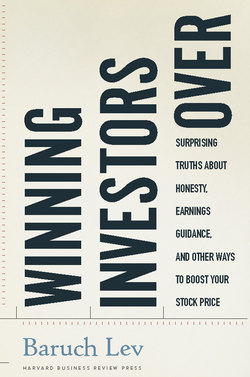Читать книгу Winning Investors Over - Baruch Lev - Страница 38
На сайте Литреса книга снята с продажи.
Innocent Victims
ОглавлениеWho bears the cost of financial information manipulations? Primarily the innocent bystanders—shareholders. James Lockhart, Fannie Mae’s regulator, told the U.S. Senate in June 2006 that Fannie’s $11 billion misstatement cost shareholders up to $30 billion.35 These huge shareholder losses are, of course, dwarfed by the cost of Fannie’s and Freddie’s implosion in the 2007–2008 financial crisis to investors and taxpayers. Jonathan Karpoff, Scott Lee, and Gerald Martin carefully estimated the loss to shareholders of 585 companies that were targets of SEC enforcement actions from 1978 to 2002 for financial-reporting violations.36 They estimated the shareholder loss by summing the stock price drops on the various public announcements related to the manipulations, such as the initial disclosure of investigation by the board or the SEC, subsequent announcements of SEC or Department of Justice actions, “Wells Notices” (SEC intent to file charges), and civil or criminal actions against perpetrators. The total estimated loss to shareholders from managers cooking the books is an astounding 38 percent share price decline, on average.37 Translated to dollars, the mean market-value loss per company is almost $400 million, and the aggregate loss over all enforcement targets exceeds $150 billion.38 Not all shareholders, of course, suffered a 38 percent loss on their investment. Some bought shares at low prices before the manipulation kicked in, others sold before the price drop upon discovery, and some were partially compensated from lawsuit settlements. Nevertheless, it’s safe to say that a price correction of such magnitude has very serious consequences for most shareholders.
These shareholder losses, estimated from stock price declines, reflect real costs, of course. According to Karpoff et al.’s computations, 9 percent of the overall shareholder value loss reflects legal penalties39; a quarter of the value loss represents a reality check—the correction of the erstwhile manipulation that inflated the stock price. The remaining two-thirds of the shareholder value loss represents, in the researchers’ phrase, reputational loss: investors’ expectation of the cost of customers bailing out or adversely changing business terms with a company caught cheating and whose survival prospects have diminished; the cost from suppliers reassessing their relationship with the company; the increased cost of capital charged by lenders concerned with the integrity of the firm and its managers; and the obvious impediments to future stock or bond issues. Key talent leaving a business tarnished by scandal coupled with the considerable and protracted distraction of management dealing with investigations and lawsuits add to the heavy reputational loss.
In case these “averages” seem abstract, consider Computer Associates, renamed CA, after its massive information manipulation. A Fortune article recounted how, two years after the revelation of the multiyear manipulation of reported sales and earnings and the installment of a new management, the company—a large supplier of software for businesses—is still struggling with restatements, consensus misses, bonds downgraded to junk, cash flow shortfalls, and, perhaps most seriously, “an exodus of executive talent.”40 The company was in probation, operating under a court-appointed monitor, as a condition of deferring prosecution, and the new CEO expects the cleanup to last five years! As for CA’s reputation, the article quoted a Gartner analyst saying, “I think this whole image perception is going to take years to get by.”
In the meantime, at Nortel—another prominent manipulator of the early 2000s—a Wall Street Journal lead article described earnings restatements stretching back several years and predicted that internal controls and financial reporting problems “will continue to take significant time and effort”; quoting the new CEO, “It’s going to take three to five years to recreate a great company.”41 Hope springs eternal; in January 14, 2009, Nortel filed for bankruptcy. A mercy killing.
The root cause of the downfalls of Computer Associates, Nortel, Fannie Mae, and the multitude of less illustrious cookers of books was, of course, a business deterioration that the manipulators intended to mask. Manipulations, however, not only fail to mask serious business deterioration for long, but also exacerbate the deterioration and wreak havoc on efforts to reverse the downward trend. Skeptical, often hostile shareholders, suppliers, and customers, harmed by the manipulation, along with disillusioned employees, vengeful prosecutors, and class-action lawyers, are often reluctant to participate in restructuring plans and sever credit and supply lines, distract managers’ attention, and cost a fortune to mollify. No wonder that this “reputational loss” shaves a quarter of shareholders’ value by Karpoff et al.’s estimates (two-thirds of 38 percent price decline).
But it’s not only shareholders who pay the price of financial misrepresentation; employees and the economy at large are seriously damaged, too. Simi Kedia and Thomas Philippon highlight an intriguing facet of the social cost and waste wrought by reporting manipulation.42 They argue that earnings manipulation is not convincing unless it is accompanied by real increases in corporate investment and employment. Thus, in order to persuade investors that the reported (manipulated) sales and earnings growth is real, the manipulators must mimic the investment and employment patterns of their genuinely high-performing counterparts. High reported earnings with employee layoffs don’t seem credible. Using a sample of four hundred companies that restated earnings for misreporting reasons from 1997 to 2002, Kedia and Philippon demonstrate that these companies increased their head count during the manipulation period by 3.7 percent more than similar (same size, age, industry) nonrestating companies and boosted their property, plant, and equipment by 5 percent more than honest comparables. Alas, after restatement, both employment and investment plummeted relative to the nonrestating companies.43 Keeping the business-as-usual facade led the manipulators to shed between 250,000 and 600,000 jobs from 2000 to 2002. Heavy are the costs of manipulation.
